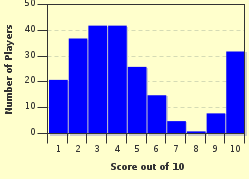Quiz Answer Key and Fun Facts
1. Why shouldn't you touch your beaker or weigh boat with your bare hands when weighing out a sample?
2. Is it important to dry your glassware between successive titration trials, if you are using the same flask to run replicates of the same solution and rinsing with DI water?
3. When performing absorption spectra analysis in the UV/Vis range. Why are high absorbance values (>1) considered to be poor representatives of the true absorbance of the sample?
4. If I want to prepare 100mL of a mixture using only a 10mL pipet, what would the error of the 100mL mixture be if the error in the pipet is 0.2 mL?
5. What does a PMT (photo multiplier tube) do?
6. Now for a little biochemistry. What chemical is commonly added to agar (which is intended to grow E. coil) that is crucial in blue/white screening?
7. You want to separate a mixture of compounds using gel permeation chromatography. What compound, do you predict, will be the first to elute?
8. Analysis- If a pathway of a particular substrate to product that is crucial for life is studies by creating mutant knockouts for the 3 genes responsible for the enzymes in this pathway. The pathway consists of a starting material, two intermediates, and a final product. (call them A B C and D). For clarity, Each plate is only supplemented with one factor, meaning if it grows on A and B plates, then it grows on a plate supplemented with A alone and a plate supplemented with B alone).
Strain 1 grows on plates containing A, but not on plates containing B C or D)
Strain 2 grows on plates containing C and A but not on plates containing B or D
Strain 3 grows on all 4 plates
Strain 4 grows on A D and C but not on B plates
What is the order of starting material intermediates and final product?
9. In column chromatography, specifically in TLC (thin-layer chromatography), what is the retention factor?
10. If you notice that your data isn't fitting the theoretical model it is supposed to fit, it is best to... (assume you're a student and the lab report is due tomorrow)
Source: Author
dgbayer
This quiz was reviewed by FunTrivia editor
crisw before going online.
Any errors found in FunTrivia content are routinely corrected through our feedback system.

